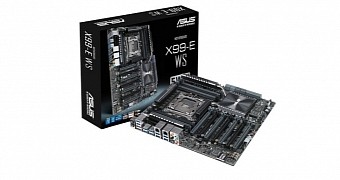The LGA 2011-3 socket that comes with the X99 chipset is meant to support Haswell-E Core i7 central processing units from Intel, and it does. However, there is one mainboard based on it that stood out to us a couple of weeks back: the ASUS X99-E WS.
Back then, we told you that the reason the board had caught our eye was the large number of PCI Express slots: seven, which work fully even if all are populated.
Now, there is another reason to take a second look: the CPU socket. We told you, at the start of the month, that ASUS had designed a different socket from all those seen on the Haswell-E mainboards released so far.
Specifically, the LGA 2011-3 socket that could not be called LGA-2011, exactly, because it did not have 2,011 pins. Instead, it had 2,017, because ASUS added a few extra.
It appears that the X99-E WS motherboard is one of the platforms featuring that particular socket.
LGA 2017 means both Core i7 and Xeon support
Leading up to the launch of the LGA 2011-3 socket, it was said, repeatedly, that the same socket would handle the Xeon E5-2600 v3 central processing units. You know, the ones with up to 18 cores and 45 MB L3 cache.
However, it would appear now that it's not just a matter of sticking the workstation-grade processor on an LGA 2011-3 mainboard and hoping for the best.
We've received some information from a third-party source, people who have been testing the mainboard for their own purposes.
It turns out that the extra six pins are there to enable Xeon support in addition to Core i7-5000X Extreme Edition processors. Also, this functionality is reliant on a BIOS update you have to access through a link included in the user guide that comes with the board.
On the bright side, once you have the BIOS installed you can expect the 2015-bound Skylake Intel CPUs to work on the motherboard as well.
The extra pins will also provide greater overclocking potential for both the CPU and whatever DDR4 memory modules you may have installed. Seven PCI Express slots that can be used at once
This was the other big eyebrow raiser on the ASUS X99-E WS motherboard. The platform has no fewer than seven slots, instead of four or five.
We speculated that a third-party controller had to have been used in order to make them all work, since the LGA 2011-3 socket only has 40 lanes, and it seems we were right.
Thanks to a PEX 8747 PCIe controller, there are 88 PCI Express lanes. 40 from the CPU socket 48 from the controller chip. Thus, you can run five PCI Express x16 video cards at once and still have one left, which works in x8 mode.
It may be too much for even quad-channel gaming modes (NVIDIA SLI and AMD CrossFire), but then again this is a workstation board. GPU computing is the name of the game here, and that's exactly what the folks who wrote to us are using it for.
According to them, they got four EVGA Titan Z Hydro Copper cards (4 x16 slots), plus a Cubix xpander in the fifth slot (1 x16), plus a soundcard or whatever else in the final slot (also in x8 mode).
The Cubix xpander card allowed them to add 16 more EVGA Titan Z Hydro Copper video cards, leading to an astonishing 20 EVGA Titan Z Hydro Copper. These are each dual-GPU adapters with 5760 CUDA cores, meaning a total (absurd, almost) 115,200 CUDA cores for the whole system.
Combine these tremendous resources with the ridiculous overclocking inherent in the modified LGA 2011-3 socket and there isn't much you can do but stare.
We're still waiting for some better pictures of the modified socket. We'll post them in a follow-up blog when we get them.

 14 DAY TRIAL //
14 DAY TRIAL //